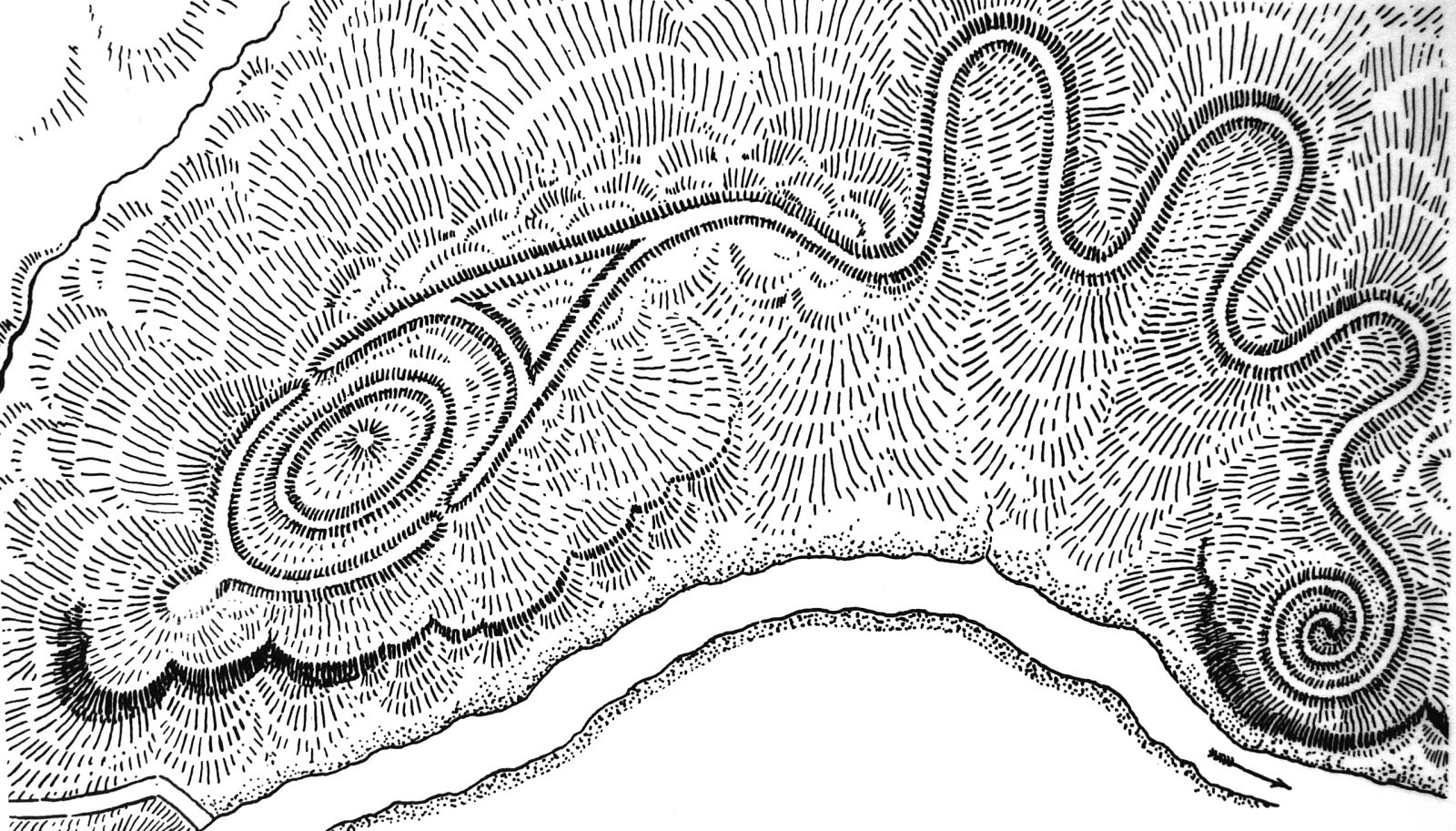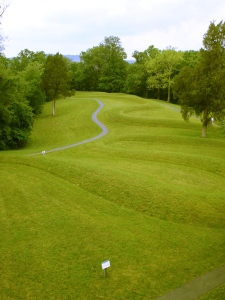
We really don’t know for sure what most ancient, pre-literate cultures used many of their monumental constructions for. We’re reasonably sure about things like the pyramids of Egypt and the temples of Greece, but these examples of architecture were constructed during periods in which there was writing, so their builders discussed the significance of monumental architecture in their life times.
But what of Stonehenge? Nabta Playa? The Nazca Lines in Peru? We can make some guesses -some very educated guesses- but we still cannot be as certain of the use and purpose of these sites as we can of those mentioned in the previous paragraph.
The same holds true for the Serpent Mound in Locus Grove, Ohio, which was constructed by local Native Americans at around 1000 CE. Nor do we truly know the purposes of other earthworks in the Ohio Valley -were they fortifications; were they mortuary; were they cult centers; or some combination of these? While not as old as many of the mounds built by the Hopewell and Adena cultures (1000 BCE to about 700 CE), the Serpent mound is, perhaps, one of the most famous and popular of the earthworks in the Ohio Valley -maybe even the United States.
Interpretations of the Serpent Mound
Modern inhabitants of the region first surveyed the Serpent Mound in 1846 and was initially recognized as a serpent that appeared to be swallowing or ejecting an egg from its mouth.
Several decades later, Francis Parry offered a new interpretation which was analogous to symbols found in Southwest Native American cultures. He suggested that the oval was a Sun sign and the coil at the tail the wind sign. The wavy body in the middle was interpreted by Parry to be the aboriginal cloud form.
And, just so we can all rest assured that the cloud of ignorance perpetrated by modern fundamentalist Christians is nothing new, let me mention another interpretation of the Serpent Mound. Reverend Landon West of Pleasant Hill, OH suggested that the mound represented man’s fall from grace in which “Satan beguiled and tempted Eve” to taste of the forbidden fruit. Clearly, Landon thought, this was created by the hand of God directly or, at least, through one of his nutters.
More recently, rational analysis has yielded to a more rational interpretation. By comparing the mound with the anatomy and striking habits of real snakes, researchers now see the oval portion at the head of the snake as its mouth and the triangular-shaped portion behind the head as the neck, which is
“puffed out†by inflation in certain species when agitated. Native American cultures were careful observers of nature, to the point that I would characterize them as “scientists†of a sort -they observed the habits and behaviors of animals and the universe, making predictions and assumptions that held true when hunting, or just determining the seasons. It’s very likely that the snake was a totem figure and venerated by the culture that built the mound in the same way it was venerated and respected by cultures around the world. If one is to create a mound to honor a snake, then the logical course of action is to show it in the position of action: striking!
Incidentally, the Serpent Mound is situated on a ridge that is on the edge of a massive crater, probably created about 300 million years ago when a small asteroid impacted the region. Its very doubtful that the Native Americans that constructed the mound had any clue of this, but it is interesting that the head and the tail both are situated near cliff-faces of the ridge (there’s an overlook at each end). Though completely unaware of the asteroid impact, the mound’s builders may have, indeed, been aware of other details of astronomical significance, namely the summer and winter solstices. This is consistent with the level of knowledge and technology of other mound-building societies of the world, suggesting a need to have an accurate method of tracking and celebrating the seasons for agricultural purposes.
mound’s builders may have, indeed, been aware of other details of astronomical significance, namely the summer and winter solstices. This is consistent with the level of knowledge and technology of other mound-building societies of the world, suggesting a need to have an accurate method of tracking and celebrating the seasons for agricultural purposes.
Because of this, I rather liked the interpretations that include an egg being consumed or ejected by the snake, since most societies rightly view the egg as a symbol of fertility and fertility is necessary for agricultural societies.
I was at the Serpent Mound just a two weeks ago and I have to say that the nearest town, Locust Grove, is aptly named. There were thousands of cicadas, close cousin to the locust, in the trees buzzing in unison and, occasionally, dropping down on the heads of unassuming passersby. Here’s one such cicada. Colorful little buggers.


Miroslav Provod centrum11@volny.cz
Serpent mounds
Serpent mound is a clay mound that is shaped in meandering curves, which form more energy in their inner bents due to the increased density of zones. The condition for it’s functioning is the same as with other megalithic structures – it must be placed into a location with enough cosmic energy (details can be found at http://www.miroslavprovod.com There were many serpent mounds built, but a mound that looks like a snake that is trying to swallow an egg seems to be the most perfect one. It is a mound with four different energetic degrees:
– six locations of a meandering shape of the same energetic value (half of a winding)
– one location of greater energy in the shape of an egg (one whole winding)
– one location of even greater energy in a triangular winding
– and one last location of a different degree of energy in the tail part, which is formed by the combination of the meander with the spiral
The energetic function of the mounds could be proved by an easy experiment, during which the energy would be measured by a method, which is described in detail in my article “Dowsing versus auraâ€. To perform this experiment, we need about 10 metres long hose with water flowing in it and any rock of about 60Kg mass.
Firstly, we place the rock next to the hose with flowing water, which is placed linearly, and we monitor the energetic gain of the rock in various time intervals. In the second part of the experiment, we shape the hose into a meandered shape, place the rock to its centre and then monitor the energetic gain. I recommend continuing with the experiment in a way that we form a whole winding around the rock and then more windings. Interesting results could be found if these experiments are repeated with different flows in the hose, etc. When the rock is placed away from the source, it will slowly loose its energy. If we replace the rock by a figurant, the matter of its body will be gaining energy in the same way as the rock. It could be concluded from these experiments that the clay mounds of a serpent shape gave people an energetic place to increase their energy in the same way as menhirs, dolmens and other prehistoric structures. Water streams are not the only energetic source for the constructions of mounds and other similar structures; there could be other sources like underground springs, deposits of metal ores, crossings of zones, etc.
IT’S NECESSARY to remind – and I emphasize this – that at the times of constructions of the megalithic structures, the grid of energetic parts wasn’t affected by the civilization sources. Some sources could therefore be located in other locations, and many mounds or other energetic structures may not be functional anymore.
The burial-ground of the rulers of Egypt “The kings’ valley†is situated in a meander of river Nile. There are hundreds of thousands of megalithic structures in the world that are built in the inner bends of water streams, meanders and confluence of rivers. There are also a great number of megalithic and religious structures built above the underground springs. The curvature of any matter works in the same way as a curve of a water flow, but only given that the matter has enough energy. In Malta in the Mediterranean and in other places, there were ritual meeting places for people built in an ellipsoidal shape, partly submerged underground. Domes, vaults, apses, circular structures and other rounded structures have the same qualities that strengthen the energy. Some nations, for example the Celts, constructed clay mounds of squared or rectangular ground plan, where the zones were also dense, but in a different grid.
People used to supply their body energy by the use of all kinds of megalithic structures. However, this is just a first finding, which could be compared to a snowball, which eventually grows into an avalanche. It is described in technical literature, how some rocks of various chemical compositions were exactingly transported (pyramids, Stonehenge, Machu Picu and others) in order to achieve proper combinations. It’s necessary to clarify their interactions and explain the chemical processes of the rocks, which affected the energy. Therefore, it’s not only about supplying bodily energy but also about the quality of the energy and it’s transformation onto the cellular membranes in an optimal amount.
If we want to continue in uncovering the secrets of ancient past, we must begin with the fact that we can’t bluff ourselves with explanations of the megalithic cultures, which are not logical. And we must also respect the fact that we have something to do with a civilisation whose technical maturity we don’t understand yet.
Also, I think it may be favourable to find out, why was this force of nature that goes through history in the religious structures until our age concealed and who wanted it to be concealed.
July 2008
Miroslav Provod
At first, I was tempted to simply delete the above post as copy/paste spam, doubting that Mr. Provod actually took the time to write all that specifically on this blog. I’m willing to bet I’d find the bulk of the pseudoscientific text above on Provod’s website or on other forums/blogs he’s written on.
Instead, it occurred to me that I would simply be opening myself up to that tired argument that skeptics are “oppressing” the nuts and cranks who call their views on science “alternative” (as if there is an alternative way of knowing that makes sense for such things).
So, what I plan to do is start a separate blog post, based on Provod’s comment, and I’ll submit it to the upcoming Skeptic’s Circle for their amusement and comment.
I’ll finish that post tonight then edit this comment with a hyperlink.
Edit: Here’s the link to the response to Provod -who never returned, btw.
do you think the site has any relation to effigy mound sites further west? i forget what people have said about this.
also, your link from your more recent post about the psudo-sci is busted :/
The Serpent Mound is definitely *an* effigy mound -being the effigy of a snake. As to its relationship to other effigy mounds, I’d say that there’s at least an indirect link in that they had similar forms and functions (ritual/funerary). Not having had the opportunity to study them at length, I really couldn’t comment on any direct links, either temporally or spatially. Perhaps the effigy mounds were like chrome wheels on cars: many different cultures of people like them for many different reasons. Yet the basic form and functions are the same.
With regard to busted link, which one and how so? Did you mean Provod’s site? I took a brief look at his site, which is laid out like a book. I’ve seen several pseudo/woo sites like this over the years. It’s an interesting phenomenon and enough to make one wonder where the line between crank and non-crank site truly is.
The comment concerning serpents’ striking caused me to look just a bit differently at the mound…if you take what can be a head beyond the “egg” area and compare this to the hood of a cobra, there are interesting similarities. Also, I found no one addressing the concept of the Orm, found in Viking mythology. Anyhow….
I believe you should get your information directly from the Native American Indians stories and teachings. Their ancestors built the mounds and therefore they will know what they were build for and why.
Essentially, that’s what archaeologists do. Ethnography is taken into account (stories and oral histories are included in this), but the cultures that built these mounds are long dead. Asking extant decendants why or how they were built is a bit like asking someone of European descent why Stonehenge was built or how Thracian tombs were built. Since there aren’t any written accounts or reliable oral histories, archaeologists combine what we know about more recent cultures of region with the material remains of the past in order to put together some good ideas. This an obviously flawed method, but it’s the best method available.
Very interesting article! I teach about the Great Serpent Mound in my Art History class. Gardner’s “Art Through the Ages” proposes an interesting theory: the Serpent Mound was constructed around 1070 AD, and one of the brightest sightings of Halley’s Comet was in 1066. Perhaps the mound was constructed to commemorate this event? (The very same comet sighting appears in the Bayeaux Tapestry as a divine prophecy for the Battle of Hastings.)